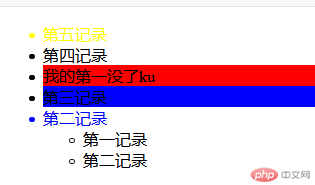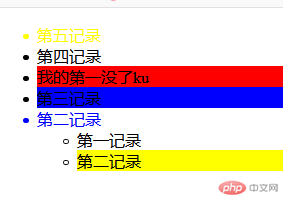- jQuery 是一个 JavaScript 的函数库,封装了很多 JavaScript 的常用代码。
- 使用 jQuery,用很少的代码实现功能,如选择器,Ajax
jQuery()工厂函数
- jQuery()函数是jQuery的全局基础函数,可简写为$();
- 调用$()函数返回的是jQuery对象,却不是构造函数,而是工厂函数,所有jQuery的方法都需要通过工厂函数调用
$()工厂函数的四种使用方式
演示HTML元素
<div class="container"><ul><a href="" id="logo">LOGO</a><a href="">视频</a><a href="">博客</a><a href="" class="faq">问答</a></ul></div>
选择器
- 把$()函数作为css选择器,通过HTML元素的标签名、类、id等获取到元素,进而对元素进行处理
//元素选择$("div").css({ border: "1px solid red ", width: "500px"});//class类选择$(".container").css("background-color", "lightblue");//id选择$("#logo").css("color", "yellow");//其它选择器$("ul a:nth-of-type(2)").css("font-size", "1.2em");
效果图:
JS对象
- 把js对象包装成jQuery对象
var as = document.querySelectorAll("ul a");$(as).css("text-decoration", "none");
效果图:
HTML元素
- 将HTML元素包装成jQuery对象
$("<a href=''>手册</a>").insertAfter(".faq");
效果图:

回调函数
- 当html文档结构加载完成后就会立即执行这个回调
- 在不同的浏览器中这个顺序会不一样,在Chrome浏览器中点弹出框之后背景演示才改变,而Firefox浏览器中弹出的时候就已经变了。
$(function () {$(document.body).css("background-color", "lightgreen");alert("页面加载完成");});
效果图:
Chrome浏览器:


Firefox浏览器:

jQuery查询结果处理
toArray
- 将查询结果转为数组
var as = $("ul>a");//转为数组var asArr = as.toArray();console.log(asArr[0]);console.log(asArr[1]);
效果图:
$.each()遍历
var res = as.each(function (index, value) {if (index === 2) {$(this).css("color", "white");}});
效果图:
$.map()遍历
- 必须要有返回值
res = as.map(function (value, index) {return value;});console.log(res);
效果图:
$.index()
- 返回查询结果中的索引
as.click(function () {alert("你点击了第" + ($(this).index() + 1) + "个A标签");});
效果图:
完整演示代码
<!DOCTYPE html><html lang="en"><head><meta charset="UTF-8" /><meta name="viewport" content="width=device-width, initial-scale=1.0" /><title>jQuery</title><script src="../jquery-3.5.1.js"></script><style></style></head><body><div class="container"><ul><a href="" id="logo">LOGO</a><a href="">视频</a><a href="">博客</a><a href="" class="faq">问答</a></ul></div><script>//jquery()工厂函数,简写$().//jQuery()函数的4种用法//1.选择器//元素选择$("div").css({ border: "1px solid red ", width: "500px" });//class类选择$(".container").css("background-color", "lightblue");//id选择$("#logo").css("color", "yellow");//其它选择器$("ul a:nth-of-type(2)").css("font-size", "1.2em");//2. js对象,把js对象包装成jQuery对象var as = document.querySelectorAll("ul a");$(as).css("text-decoration", "none");//3. HTML元素$("<a href=''>手册</a>").insertAfter(".faq");//4.回调函数$(function () {$(document.body).css("background-color", "lightgreen");alert("页面加载完成");});/*</script></body></html>
获取和设置元素的属性值
html演示代码
<!DOCTYPE html><html lang="en"><head><meta charset="UTF-8" /><meta name="viewport" content="width=device-width, initial-scale=1.0" /><title>jQuery</title><script src="../jquery-3.5.1.js"></script><style></style></head><body><div class="container"><h2></h2><form action="" method="POST"><input type="text" name="username" /><input type="password" name="password" /><button>登录</button></form></div></body></html>
attr()方法
- attr(),用于设置和获取HTML元素的属性
- $.attr(属性名),获取元素的属性值
- $.attr(属性名,属性值),设置元素的属性并赋值
<script>var form = $("form");//获取属性console.log(form.attr("action")); //<empty string>//设置属性form.attr("action", "login.php");console.log(form.attr("action")); //login.php
css()方法
- css()方法主要针对HTML元素的style属性进行操作,也可以获取到元素的所有样式
console.log(form.css("border")); //<empty string>//通过js对象设置多个样式form.css({width: "400px",height: "200px","background-color": "lightblue","text-align": "center",});

val()方法
- val()方法针对表单元素的值,
//val()//自动填充用户名密码console.log($("#password").val()); //<empty string>$("#password").val("password");$("#username").val("admin");console.log($("#password").val()); //password

html()/text()
- 设置元素标签的内容
- html()可以识别内容中的HTML标签
- text()纯文本内容
//html()/text()$("h2").html("<strong>用户登录</strong>");$("h3").text("<strong>用户登录</strong>");

jQuery操作DOM
html演示代码
<!DOCTYPE html><html lang="en"><head><meta charset="UTF-8" /><meta name="viewport" content="width=device-width, initial-scale=1.0" /><title>DOM操作</title><script src="../jquery-3.5.1.js"></script><style></style></head><body><div class="container"></div><script></script></body></html>
元素的插入与替换
- append(),在尾部插入元素
- 父元素.append(子元素)
- 子元素.appendTo(父元素)
<script>//添加元素$(".container").append("<ul>");//append$("ul").append("<li>第一记录</li>");//appendTo$("<li>").text("第二记录").css("color", "blue").appendTo("ul");

- before() 添加元素到某个元素之前
$("ul>li:last-of-type").before("<li >第三记录</li>");

- prepend、prependTo,插入元素到头部
("ul").prepend("<li>第四记录</li>");$("<li>").text("第五记录").css("color", "yellow").prependTo("ul");

- replaceWith()替换元素
$("ul>li:nth-of-type(3)").replaceWith("<li>我的第一没了ku</li>");

——
过滤器
- 对查询结果进行再次筛选
- filter()、first()、last()、eq()
$("ul").append("<ul><li>第一记录</li><li>第二记录</li></ul>");//过滤器,filter()$("ul>li").filter("#first").css("background-color", "red");

//eq(),根据索引选择$("ul>li").eq(3).css("background-color", "blue");

//find(),查找所有层级,last()查找结果中的最后一个//$("ul").find("li").last().css("background-color", "yellow");


